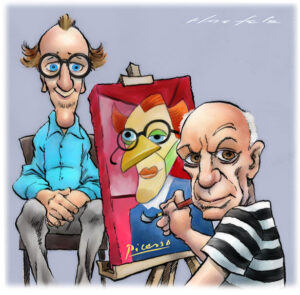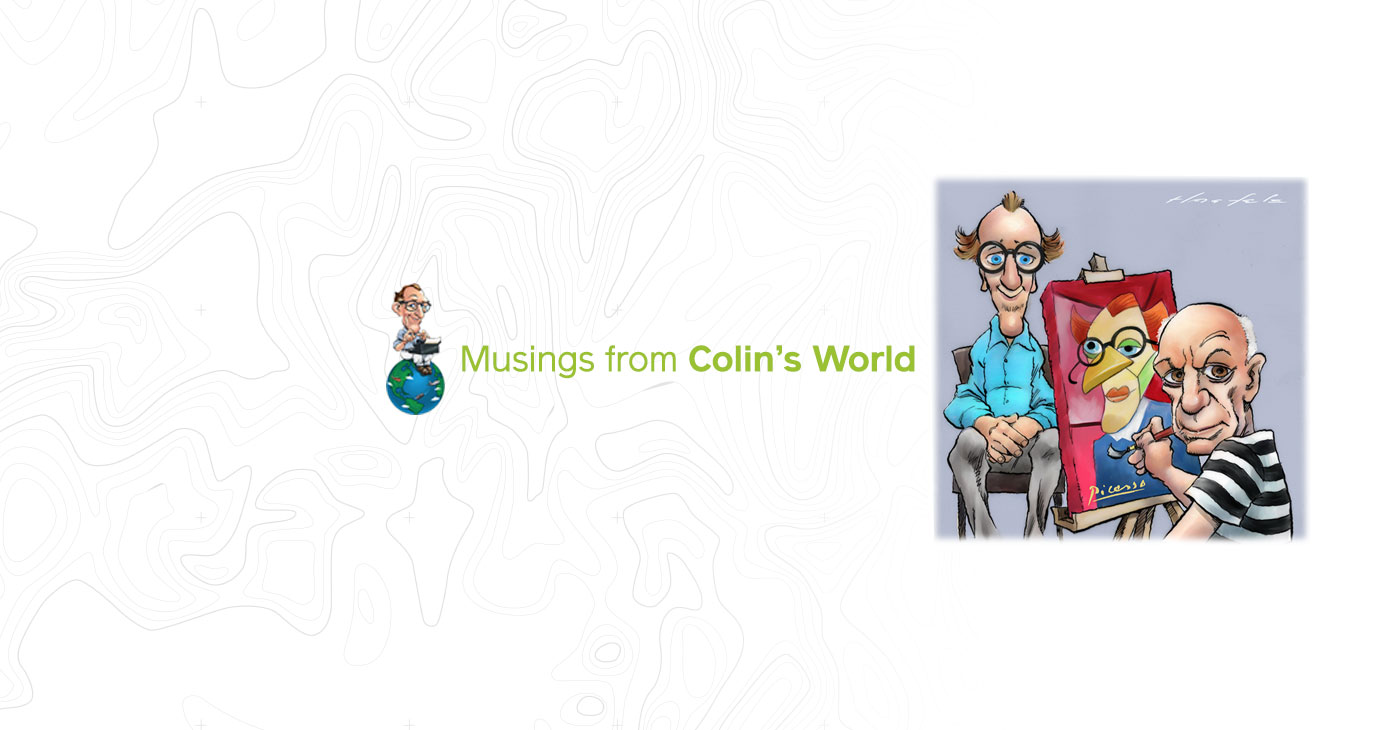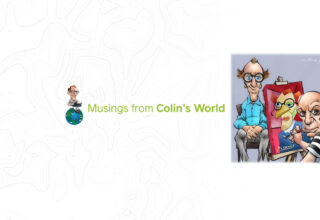I love maps. I can pore over them endlessly. No matter how well I think I know a place, when I look at a map I see much I was not aware of. At the same time, as the Polish-American philosopher Alfred Korzybski pointed out, the map is not the territory. When you are actually in a place you experience a great deal that is not on any map.
I find that no place is ever quite what I imagined it to be. It’s always a great deal more. When I went to Spain, I was struck by many things that had never occurred to me. For example, I had always thought of Spain as part of Europe, which it obviously is. But when I was traveling across the countryside and visiting the cities, I kept noticing what felt like an affinity with Africa.
Once that had occurred to me, I realized it shouldn’t have been a surprise. Spain and Africa are right next to each other. At the Strait of Gibraltar, they are only separated by eight miles of easily navigable water. There you can see Morocco from Spain and vice versa. Before railroads and cars were invented, the sea was by far the most effective means of long-distance travel. So historically, Spain is in some ways closer to Africa than Europe.
In contrast, Spain is separated from France and the rest of Europe by the mighty Pyrenees mountain range, which forms a formidable barrier. That reinforced Spain’s individual character development, and its independence from the rest of Europe. Spain has developed its own distinct character, and through its colonial empire, it spread that culture around the world. Like all colonial empires, Spain had its oppressive side. But overall, its cultural legacy is irresistibly charming.
I also discovered a geological basis for the affinity between Spain and Africa. In terms of continental drift, the movement of landmasses over the crust of the earth over millions of years, Spain was previously part of the African landmass. It collided with the Eurasian landmass millions of years ago, and the pressure created the Pyrenees Mountains. So Spain has a deep affinity with Africa in the land itself.
But probably most of the affinity I felt between Spain and Africa was based on the presence of the Moors, out of Northern Africa, who occupied Spain for nearly 800 years, 711 to 1492.
The Berber-Hispanic Muslims inhabited two-thirds of the Iberian Peninsula for 375 years, occupied about half for another 160 years, and stayed in Granada for another 244 years. Such cultural influences run deep and do not disappear quickly. The Moorish culture remains a palpable part of the experience of modern Spain.
 In the 20th century, the Spain-Africa affinity was reflected in the art of Pablo Picasso, probably Spain’s most celebrated artist. He began his career ably mastering the styles of his predecessors, from Rembrandt through Gauguin and Van Gogh. Then he discovered African art, which led to a revolution in the way he saw things. He deconstructed the world and put it back together in a shocking new way. That was the birth of Cubism. It wasn’t just a style that came and went, it forever changed the way we see things and represent things in art.
In the 20th century, the Spain-Africa affinity was reflected in the art of Pablo Picasso, probably Spain’s most celebrated artist. He began his career ably mastering the styles of his predecessors, from Rembrandt through Gauguin and Van Gogh. Then he discovered African art, which led to a revolution in the way he saw things. He deconstructed the world and put it back together in a shocking new way. That was the birth of Cubism. It wasn’t just a style that came and went, it forever changed the way we see things and represent things in art.
As I toured Spain and experienced the unique character of each of the cities, I realized that each had developed independently during the centuries before the establishment of a national entity called Spain.
It was in the watershed year of 1492 that the Christian kingdoms of Castile and Aragon conquered the Emirate of Granada, ended Muslim rule in the south, and founded Spain as a united state.
The presence of Rome is also spread across the country, as in nearly all of Europe and North Africa. You run into enduring Roman artifacts nearly everywhere, such as in Córdoba where there still stands a great Roman bridge and a giant waterwheel.
Traveling cross country was thrilling because the landscape itself, with its awe-inspiring Sierra Nevada mountains and great expanses of rolling plains, has heart-stirring beauty. It seems to speak quietly and grandly of its own ancient history. But it’s the cities where people gather and culture is concentrated in so many artifacts, where you can really get a feel for the human history of the place.
Each of the cities I visited left its own parcel of personal memories: Barcelona, Madrid, Seville, Córdoba, Granada and Malaga. Each felt unique and individual when I was there, and left strong impressions that characterize my memories of them.
Barcelona is the glorious Mediterranean seaport in the northeastern part of Spain, as breezy and beautiful as its name is musical, dancing off the tongue. Barcelona was the capital of Catalonia, and was one of the first Roman settlements in Spain, founded by Emperor Augustus around 15 BC. You can still see Roman walls and ruins there.
One of my most vivid memories of Barcelona is the amazing Gaudí Cathedral. It was inspired by medieval Gothic cathedrals built from the 12th to the 15th century. But it was built in the late 19th century. It’s considered Catalan Modernisme, or Art Nouveau. It’s strange and riveting to look at, colossal and ornate in a bizarre way. It embodies the flair and flamboyance of Barcelona. I loved the city’s Art Nouveau architecture, and the ornate iron railings and stone work.
Barcelona also captured my heart because it was the capital of Catalonia, where the first resistance to fascism rose up in the late 1930s in what became the Spanish Civil War.
Madrid is the great cosmopolitan center of Spain, right in the middle. With a population of nearly 3 million, it’s by far Spain’s largest metropolis. It’s the home of the great Museo Nacional del Prado, one of the world’s greatest museums, as well as the Reina Sofia museum, which houses Picasso’s “Guernica,” another statement on the Spanish Civil War. The streets of Madrid are exciting, with art pieces displayed outdoors, sidewalk cafes, and lively street life. And there’s the massive Palacio del Oriente, the Royal Palace now used for events and as a tourist attraction.
Seville had what is said to be the first tobacco factory, from the 18th century, which was the setting of the opera “Carmen” by the French composer Bizet. Seville is the capital of the region of Andalucía, with beautiful rolling hills and villages, and houses on hillsides. It’s the home of Flamenco music and dance, and a good place to experience the real thing. It’s the final resting place of Columbus and also the location of the amazing Alamillo Bridge, designed by Santiago Calatrava using a harp-like structure. And it’s where tapas originated.
Córdoba was a Moorish city, and center of the Arabic world. The Cathedral of Cordoba shows a fascinating conglomeration of Muslim and Christian cultures. It was once a Mosque, and still shows signs of its earlier incarnation, now overlaid by Christian symbols. Cordoba was also the birthplace of the great bullfighter El Cordobés.
Granada, in the foothills of the Sierra Nevada in southern Spain, was the headquarters of the Moors in Spain. It’s known mostly for the Alhambra, their palace. The Alhambra, or “Red Castle” in Arabic, is a mind-numbingly spectacular palace and grounds, full of ornate, Moorish art and design, revealing a very rich and developed nation that existed there from the late 9th century until the Moors were chased out in 1492 by the rising new Spanish nation.
Málaga is an Andalusian city on Costa del Sol. It was the birthplace of Picasso in 1881, and is the home of the Museo Picasso Málaga, a museum devoted to Picasso. Málaga was also the site of a romantic legend of Lovers Mountain, or Lovers Rock, said to be the place where two lovers, a Christian and a Moor, jumped to their deaths rather than to be separated. Spain is nothing if not romantic.
Spain is a place of great soul, great spiritual and sensual vibrance. It is an endless source of wonder and warm pleasure, never to be exhausted.
Viva Espana!
Your humble reporter,
Colin Treadwell

